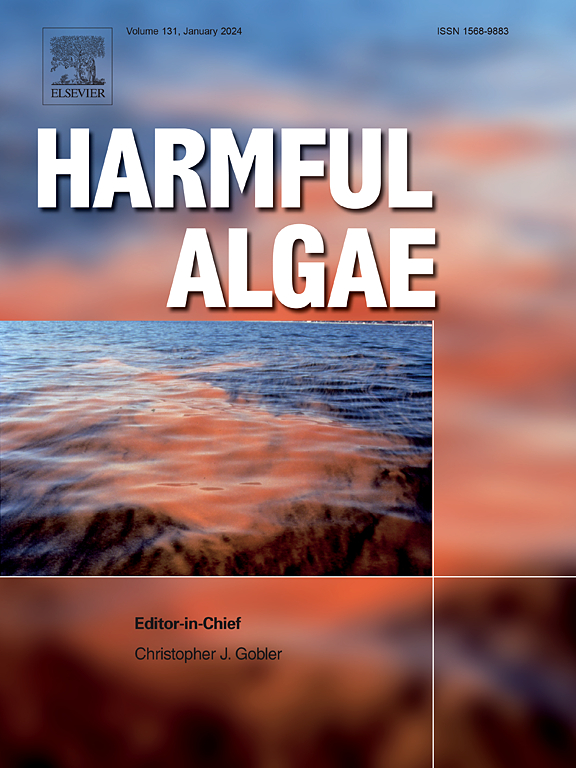形态vs毒性:温度如何重塑微囊藻在变暖世界中的适应策略?
IF 4.5
1区 生物学
Q1 MARINE & FRESHWATER BIOLOGY
引用次数: 0
摘要
全球变暖和富营养化协同加剧了蓝藻的繁殖,微囊藻产生的微囊藻毒素(MC)对生态和健康构成了重大风险。本研究研究了温度梯度(10°C、25°C、35°C、40°C)如何调节铜绿假单胞菌的生理、形态和分子适应策略,重点研究了形态可塑性和毒素产生之间的代谢权衡。我们的研究结果表明,在35°C下生长强劲,但在极端(10°C/40°C)下光合作用受到抑制。与25°C对照相比,高温胁迫(40°C)导致MC高分泌量增加101%,细胞直径增大68%,菌落碎裂44%。相比之下,低温胁迫(10°C)促进了细胞内MC的保留,外层比例增加了135%。多组学分析表明,应激条件下碳固定、氮代谢和糖酵解受到抑制,三羧酸循环、戊糖磷酸途径(NADPH产生)和谷胱甘肽代谢的代偿性激活可缓解氧化应激。值得注意的是,MC转运体基因mcyH在40°C时明显上调,伴随的多糖合成/输出(PSO)基因表达与细胞外MC水平密切相关,表明MC介导的多糖分泌具有环境适应性。然而,冷诱导的外胚层形成独立于MC调控途径。综合分析揭示了不同热策略的代谢权衡:高温胁迫有利于MC输出,菌落缩小和细胞扩大,而低温优先考虑细胞内MC储存和抗氧化系统激活。这些发现阐明了微囊藻在热胁迫下的代谢权衡,强调了通过协同形态和毒理学调整气候驱动的水华持续机制。这项研究提供了关键的见解蓝藻优势机制在变暖的水生生态系统。本文章由计算机程序翻译,如有差异,请以英文原文为准。
Morphology vs. toxicity: How temperature reshapes Microcystis’ adaptive strategies in a warming world?
Global warming and eutrophication have synergistically intensified cyanobacterial blooms, with Microcystis posing significant ecological and health risks due to microcystin (MC) production. This study investigated how temperature gradients (10 °C, 25 °C, 35 °C, 40 °C) modulate physiological, morphological, and molecular adaptive strategies in M. aeruginosa, focusing on metabolic trade-offs between morphological plasticity and toxin production. Our results demonstrated that robust growth at 35 °C but photosynthetic inhibition at extremes (10 °C/40 °C). High-temperature stress (40 °C) triggered a 101 % increase in MC hypersecretion concurrent with 68 % cell diameter enlargement and 44 % colony fragmentation, comparable to the 25 °C control. In contrast, low-temperature stress (10 °C) promoted intracellular MC retention and a 135 % increase in external layer proportion. Multi-omics analyses demonstrated suppressed carbon fixation, nitrogen metabolism and glycolysis under stress, with compensatory activation of the tricarboxylic acid cycle, the pentose phosphate pathway (NADPH production) and glutathione metabolism for oxidative stress mitigation. Strikingly, MC transporter gene mcyH was pronounced upregulated at 40 °C, and the accompanying polysaccharide synthesis/output (PSO) gene expression strongly correlating with extracellular MC levels, suggesting MC-mediated polysaccharide secretion for environmental adaptation. However, cold-induced external layer formation occurred independently of MC regulatory pathways. Integrative analysis revealed a metabolic trade-off with distinct thermal strategies: high-temperature stress favored MC export, colony downsizing and cellular enlargement, whereas low temperature prioritized intracellular MC storage coupled with antioxidant system activation. These findings elucidate Microcystis’ metabolic trade-offs under thermal stress, highlighting climate-driven bloom persistence mechanisms through synergistic morphological and toxicological adjustments. This study provides critical insights into cyanobacterial dominance mechanisms in warming aquatic ecosystems.
求助全文
通过发布文献求助,成功后即可免费获取论文全文。
去求助
来源期刊

Harmful Algae
生物-海洋与淡水生物学
CiteScore
12.50
自引率
15.20%
发文量
122
审稿时长
7.5 months
期刊介绍:
This journal provides a forum to promote knowledge of harmful microalgae and macroalgae, including cyanobacteria, as well as monitoring, management and control of these organisms.
 求助内容:
求助内容: 应助结果提醒方式:
应助结果提醒方式:


